Toyota RAV4 (XA40) 2013-2018 Service Manual: System too

Description
The fuel trim is related to the feedback compensation value, not to the basic injection time. The fuel trim consists of both the short-term and the long-term fuel trims.
The short-term fuel trim is fuel compensation that is used to constantly maintain the air-fuel ratio at stoichiometric levels. The signal from the air-fuel ratio (a/f) sensor indicates whether the air-fuel ratio is rich or lean compared to the stoichiometric ratio. This triggers a reduction in the fuel injection volume if the air-fuel ratio is rich and an increase in the fuel injection volume if it is lean.
Factors such as individual engine differences, wear over time and changes in operating environment cause short-term fuel trim to vary from the central value. The long-term fuel trim, which controls overall fuel compensation, compensates for long-term deviations in the fuel trim from the central value caused by the short-term fuel trim compensation.
If both the short-term and long-term fuel trims are lean or rich beyond predetermined values, it is interpreted as a malfunction, and the ecm illuminates the mil and sets a dtc.
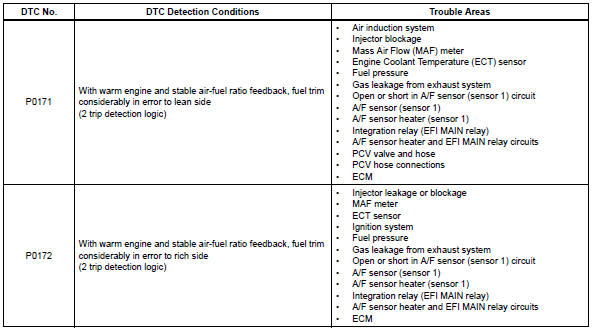
Hint:
- When dtc p0171 is set, the actual air-fuel ratio is on the lean side. When dtc p0172 is set, the actual air-fuel ratio is on the rich side.
- If the vehicle runs out of fuel, the air-fuel ratio is lean and dtc p0171 may be set. The mil is then illuminated.
- When the total of the short-term and long-term fuel trim values is within 20 % (and the engine coolant temperature is more than 75°c [167°f]), the system is functioning normally.
Monitor description
Under closed-loop fuel control, fuel injection volumes that deviate from those estimated by the ecm cause changes in the long-term fuel trim compensation value. The long-term fuel trim is adjusted when there are persistent deviations in the short-term fuel trim values. Deviations from the ecm's estimated fuel injection volumes also affect the average fuel trim learning value, which is a combination of the average short-term fuel trim (fuel feedback compensation value) and the average long-term fuel trim (learning value of the air-fuel ratio). If the average fuel trim learning value exceeds the malfunction threshold, the ecm interprets this as a fault in the fuel system and sets a dtc.
Example: the average fuel trim learning value is +35 % or more or -35 % or less, the ecm interprets this as a fuel system malfunction.
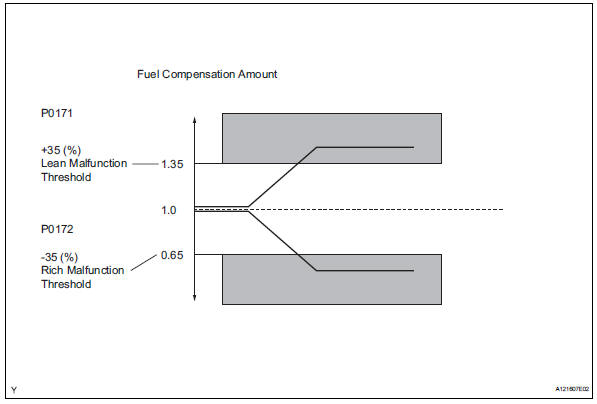
Monitor strategy

Typical enabling conditions
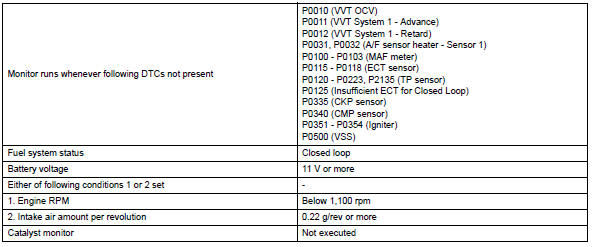
Typical malfunction thresholds

Wiring diagram
Refer to dtc p2195 (see page es-296).
Inspection procedure
Hint:
- Read freeze frame data using the intelligent tester. Freeze frame data records the engine condition when malfunctions are detected. When troubleshooting, freeze frame data can help determine if the vehicle was moving or stationary, if the engine was warmed up or not, if the air-fuel ratio was lean or rich, and other data from the time the malfunction occurred.
- A low a/f sensor voltage could be caused by a rich air-fuel mixture. Check for conditions that would cause the engine to run rich.
- A high a/f sensor voltage could be caused by a lean air-fuel mixture. Check for conditions that would cause the engine to run lean.
- Check any other dtcs output (in addition to dtc p0171 or p0172)
- Connect the intelligent tester to the dlc3.
- Turn the ignition switch on and turn the tester on.
- Select the following menu items: diagnosis / enhanced obd ii / dtc info / current codes.
- Read dtcs.

Hint:
If any dtcs other than p0171 or p0172 are output, troubleshoot those dtcs first.


- Perform active test using intelligent tester (a/f control)
- Connect the intelligent tester to the dlc3.
- Start the engine and turn the tester on.
- Warm up the engine at an engine speed of 2,500 rpm for approximately 90 seconds.
- On the tester, select the following menu items: diagnosis / enhanced obd ii / active test / a/f control.
- Perform the a/f control operation with the engine in an idling condition (press the right or left button to change the fuel injection volume).
- Monitor the output voltages of a/f and ho2 sensors (afs b1s1 and o2s b1s2) displayed on the tester.
Result: the a/f sensor reacts in accordance with increases and decreases in the fuel injection volume: +25 % = rich output: less than 3.0 V -12.5 % = Lean output: more than 3.35 V
Notice:
The a/f sensor has an output delay of a few seconds and the ho2 sensor has a maximum output delay of approximately 20 seconds.
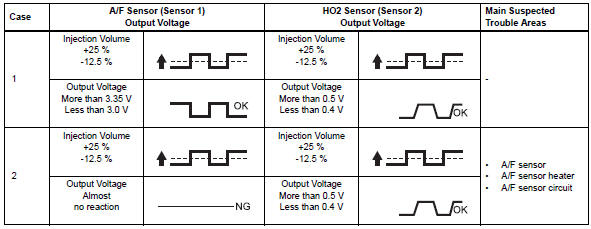

Following the a/f control procedure enables technicians to check and graph the voltage outputs of both the a/f and ho2 sensors.
To display the graph, select the following menu items on the tester: diagnosis / enhanced obd ii / active test / a/f control / user data / afs b1s1 and o2s b1s2; then press the yes button and then the enter button followed by the f4 button.

- Read value using intelligent tester (maf)
- Connect the intelligent tester to the dlc3.
- Turn the ignition switch on and turn the tester on.
- Select the following menu items: diagnosis / enhanced obd ii / data list / primary / maf and coolant temp.
- Allow the engine to idle until the coolant temp reaches 75°c (167°f) or more.
- Read the maf with the engine in an idling condition and at an engine speed of 2,500 rpm.
Standard: maf while engine idling: between 1 g/sec. And 3 g/ sec. (Shift position: n, a/c: off).
Maf at engine speed of 2,500 rpm: between 2 g/ sec. And 6 g/sec. (Shift position: n, a/c: off).


- Read value using intelligent tester (coolant temp)
- Connect the intelligent tester to the dlc3.
- Turn the ignition switch on and turn the tester on.
- Select the following menu items: diagnosis / enhanced obd ii / data list / primary / coolant temp.
- Read the coolant temp twice, when the engine is both cold and warmed up.
Standard: with cold engine: same as ambient air temperature.
With warm engine: between 75°c and 100°c (167°f and 212°f).


- Check pcv hose connections
- Check for pcv hose connections.
Ok:
Pcv hose is connected correctly and is not damaged.


- Check air induction system
- Check the air induction system for vacuum leakage.
Ok: no leakage from air induction system.


- Check for sparks and ignition (see page es-171)


- Check for exhaust gas leak
- Check for exhaust gas leakage.
Ok: no gas leakage.


- Check fuel pressure
- Check the fuel pressure (see page fu-6).
Standard pressure: 304 to 343 kpa (3.1 To 3.5 Kgf/cm2, 44.1 To 49.7 Psi)


- Inspect fuel injector (injection and volume)
- Check the injection volume (see page fu-11).
Standard injection volume: 45 to 58 cm3 (2.9 To 3.5 Cu in.) Per 15 seconds


- Inspect air-fuel ratio sensor (heater resistance) (see page es-83)


- Inspect integration relay (efi relay) (see page es-84)


- Check harness and connector (a/f sensor - ecm) (see page es-310)


- Replace air-fuel ratio sensor

- Perform confirmation driving pattern
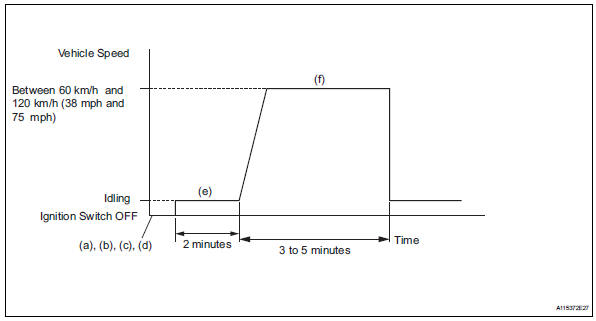
- Connect the intelligent tester to the dlc3.
- Turn the ignition switch on and turn the tester on.
- Clear dtcs (see page es-35).
- Switch the ecm from normal mode to check mode using the tester (see page es-38).
- Start the engine and warm it up with all the accessories switched off.
- Drive the vehicle at between 60 km/h and 120 km/h (38 mph and 75 mph) and at an engine speed of between 1,400 rpm and 3,200 rpm for 3 to 5 minutes.
Hint:
If the system is still malfunctioning, the mil will be illuminated during step (f).
Notice:
If the conditions in this test are not strictly followed, no malfunction will be detected.

- Check whether dtc output recurs (dtc p0171 or p0172)
- On the intelligent tester, select the following menu items: diagnosis / enhanced obd ii / dtc info / current codes.
- Read dtcs.

 Oxygen sensor circuit
Oxygen sensor circuit
Description
In order to obtain a high purification rate of the carbon monoxide (co),
hydrocarbon (hc) and nitrogen
oxide (nox) components in the exhaust gas, a twc is used. For the most effici ...
 Random / multiple cylinder misfire detected
Random / multiple cylinder misfire detected
Description
When the engine misfires, high concentrations of hydrocarbons (hc) enter the
exhaust gas. Extremely
high hc concentration levels can cause increases in exhaust emission levels. ...
Other materials:
Tire and wheel system
Inspection
Inspect tire
Check the tires for wear and proper inflation
pressure.
Standard cold tire inflation pressure:
220 kpa (2.2 Kgf/cm2, 32 psi)
Using a dial indicator, check the runout of the tires.
Standard tire runout:
1.0 Mm (0.039 In.) Or less
Rotate tire
...
Differential case
Components
Disassembly
Remove front differential ring gear
Place the matchmarks on the ring gear and
differential case.
Remove the 14 bolts.
Using a plastic-faced hammer, tap on the ring gear
to remove it from the case.
Remove front differential case ...
Downhill assist control system
The downhill assist control
system helps to prevent
excessive speed on steep
downhill slopes.
The system will operate
when the vehicle is traveling
under 15 mph (25 km/h) with
the accelerator and brake
pedals released.
WARNING
â– When using downhill assist
control system
Do not rely overmuch on the ...
